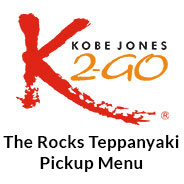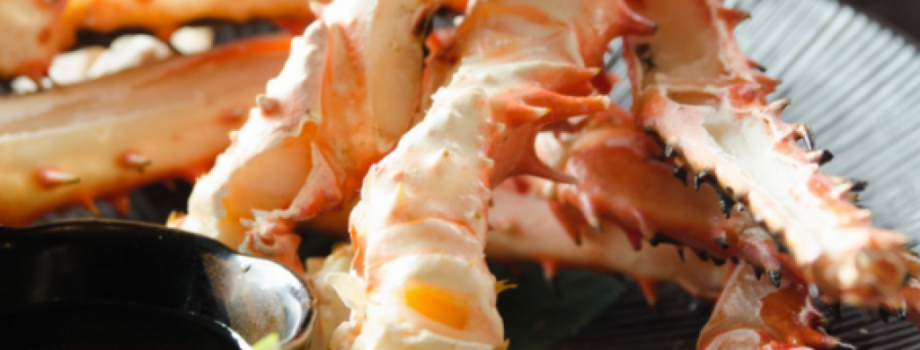Did you know that Kobe Jones purchases a whopping seven tonnes of wild caught, sustainable crab each and every year? With the average crab weighing between two and ten pounds, that’s a whole lot of deliciousness going onto our plates.
The Japanese have always loved crab, and when you taste its wonderfully decadent flavour and sample its succulent texture, it’s easy to understand why. Crab really is delicious!
But if you’ve dined in our restaurants, you may have noticed that there is something extra special about the crab at Kobe Jones. That’s because we only source the highest quality crab, ensuring it is of a particular size and holds a certain taste profile. We love to use Alaskan or Atlantic Golden Crab, which offer delicate and sweet meat that melts in your mouth, but the Blue Swimmer Crab is delicious as well – especially when blended into our famous Wafu Kani Bisque.
But what if you can’t make it to Kobe Jones, yet still want to chow down on some delicious crab? What’s the best crab you should be looking for? How can you tell what’s a good crab and what’s not? What are some of the best ways to eat crab?
We take a look in our Guide to Eating Crab…
Guide to Eating Crab
Believe it or not, there are over 4,400 varieties of crab. Not all of them are of the succulent kind, however, so knowing your crab is essential when it comes to hitting the seafood market. Let’s start with our faves:
Alaskan King Crab
Alaskan King Crab is sometimes referred to as “Japanese Crab”, and can grow to weigh an impressive 25 pounds. The red king crab (paralithodes camtschaticus) is the most prized variety, but it’s so popular that supplies are running low. The golden king crab (lithodes aequispinus) is sometimes called the brown king crab at markets, and is found in the Aleutian Islands. It’s low in saturated fat and a good source of vitamin B12, phosphorus, zinc, copper, and selenium. It has fleshy claws and legs, with sweet, rich meat, and crab caught later in the year tends to have a higher meat fill. Typically, the legs are what chefs look for, and your fishmonger may sell them pre-split. We love to serve it robata-style in the shell to highlight its sweetness, and add a splash of fresh lime.
Atlantic Golden Crab
The Atlantic Golden Crab (chaceon fenneri) is a large, non-swimming crab from the deep waters of the South Atlantic Ocean and the Gulf of Mexico. Because this species comes from very deep water, they should remain chilled below 6°C until cooked. The shell of the crab does not turn red when cooking like other varieties, and instead remains a beautiful golden buff colour. The Atlantic Golden Crab offers white meat and a delicate sweet flavour that lends itself to a variety of seafood tastes. Like king crab varieties, the Atlantic Golden Crab is best-loved for it’s leg meat.
Blue Swimmer Crab
Also known as the Blue Manna and Sand Crab, blue swimmer crabs are considered to be Australia’s most-loved edible crab. In season summer through to autumn, limbs should be intact and have no discolouration. Always lift and shake your crab before buying to ensure there is no sound of water – a trick to make crab feel more weighty!
Soft Shell Crab
Soft shell crabs are blue crabs that have molted. In order to grow larger, crabs have to shed their old shell to form a new one. During this process, the crabs are without their hard covering for only a few days, and they’re only truly soft shell crabs for a matter of hours. This makes them a delicacy we love at Kobe Jones. Our Panko Soft Shell Crab is imported from Japan, lightly deep fried and served with teriyaki potatoes and our own sweet chilli sauce.
Other good crabs to eat include:
Stone Crab
Another crab known for its lovely leg meat is the Stone Crab, a small and compact crab with extremely hard shells (as hard as stone). Hailing from the southern U.S. – Florida especially – the legs are pulled from the bodies when harvested. This is because once removed, a crab can return to the water and grow new legs ready to be harvested again.
Snow Crab
The beauty of the Snow Crab (chionoecetes Opilio) is that despite its small size, it still contains a large amount of pristinely white meat. Abundant in the Atlantic Ocean region, particularly around Greenland, Newfoundland, and in the Gulf of Maine, snow crabs are usually caught by traps or trawling. Eating snow crab legs can be time consuming and messy, but the taste is well worth the effort.
Bairdi Crab
Bairdi crab is sometimes traded under the name “Tanner Crab” and is best eaten cold. Most frozen bairdi crab is shipped to Japan, where it is then added to salads, like this easy crab salad with ponzu-mayonnaise dressing. It is usually sold as cooked clusters, meaning four legs and one claw connected at the shoulder.
Dungeness Crab
The delicious dungeness crab is found in the Pacific, from Alaska to central California. They’re caught in nets, traps, pots and on hook and line, and only the males are kept. Dungeness crabs are very meaty throughout, and sold live, they are mostly served whole where the meat is then picked out.
Tips for choosing crab
When cooking crab, it is always recommended to choose your own individual pieces of crab rather than buying pre-packaged frozen varieties. Look for the largest legs and claws and if they smell at all of ammonia, don’t buy them. Meaty crabs will feel heavy and they should be bright in colour. Alternatively, refrigerated “lump” crab meat can be a good option for salads, and is less messy to prepare (although it is often quite pricey).
Crab is a truly versatile meat and one of the best ways to sample it is with a Kobe Jones Crab Lovers Degustation, which is served with chilled Nigori Sake for $179 per person. Call or email us to book in today.






 (3 votes, average: 4.67 out of 5)
(3 votes, average: 4.67 out of 5)